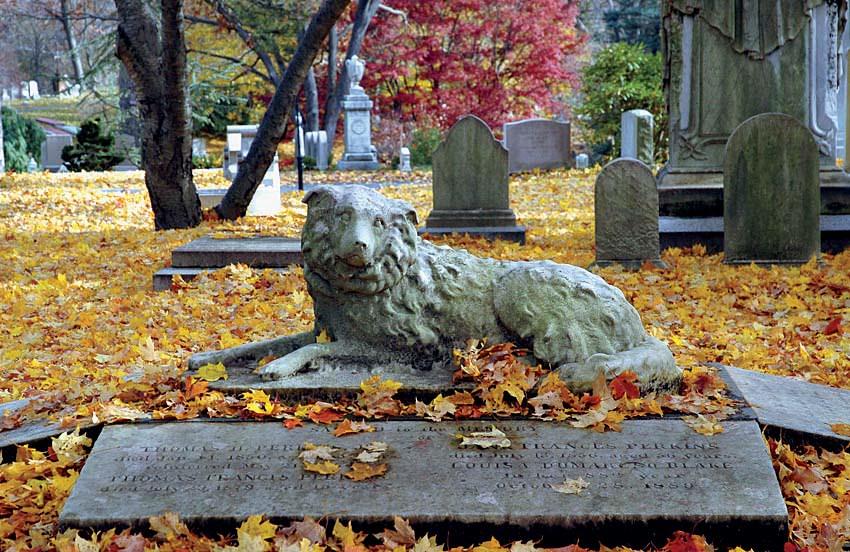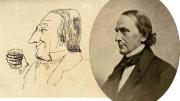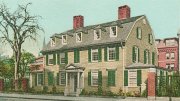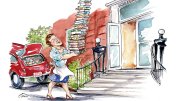Mary Saunders, curator of the Harvard Club of New York, has sent Primus this dispatch: “For many years in the old bar of the club hung a framed set of two small pen and ink doodles of a jolly man drinking. One of them appears below. It was signed with an ambiguous monogram, but not dated or labeled in any way. It seemed of some importance as it appears displayed prominently on the fireplace mantel in an 1895 photograph of the club’s entrance hall. A new bar that opened in 2003 had much less wall space, and the doodles were relocated to one of the bedroom hallways, where they have hung for the past 14 years. They joined the list of items called Mysteries of the Collection.
“Recently I saw a notice in the October 1892 issue of Harvard Graduate’s Magazine describing the club’s collection of Harvardiana. The article mentions ‘a couple of curious pen-and-ink caricatures of President Walker, drawn by a member of the Class of 1857.’ I compared the mystery drawings to a photograph of James Walker, Harvard president, 1853-1860. I wonder if you will agree that the drawing can be identified as a humorous depiction of the president, joining his students and colleagues at the bar. This would explain why it needed no identifying label for many of the club’s early years.”
Saunders finds in club records that the drawings were donated by John Codman Ropes, A.B. 1857, LL.B. ’61, LL.D. ’97, Harvard Overseer and founder of the Jacobite Club. “The artist cannot be identified with certainty,” she writes, “but my guess on the monogram is SW, and the only such initials in the Class of 1857 belong to Samuel Wells, a Boston lawyer and businessman and fellow member of the Jacobite Club. Described as a man of remarkable humor, ‘he made the most ordinary things bubble with fun.’ ”
The living who haunt Mount Auburn Cemetery in Cambridge and Watertown, Massachusetts, do so for a host of reasons. The cemetery is at once a lovely place for a stroll, a wildlife sanctuary full of birdwatchers and frog lovers, a trove of superb trees and shrubs usefully labeled, and the resting place of many interesting people. To the list we add “museum.” The Friends of Mount Auburn has recently published an informative, pleasant, and elegantly produced publication, The Art of Commemoration and America’s First Rural Cemetery: Mount Auburn’s Significant Monument Collection. The authors are Melissa Banta, consulting curator at Mount Auburn and curator at Harvard’s Weissman Preservation Center, and Meg L. Winslow, curator of historical collections at the cemetery. Of the more than 60,000 memorials on the grounds, they focus on 30 of special artistic and historical significance.

Photograph © 2007 Jennifer Johnston /Courtesy of Mount Auburn Cemetery
The marble sculpture of a Newfoundland, above, was made in 1843 by Horatio Greenough, best known for his statue of George Washington at the U.S. Capitol. It lies above a tomb housing members of the Perkins family. “Born into a mercantile family,” the authors write, “Thomas Handasyd Perkins formed one of the largest American trading houses in China in the early 1800s.” A patron of the arts, he helped found the Boston Athenaeum and was a major benefactor of what was later named the Perkins School for the Blind. He died in 1854 and was buried in Boston. The Perkins family bought a lot at Mount Auburn and in 1914 moved his body to it. Greenough’s dog became one of the cemetery’s iconic memorials. An early guidebook explained that as “history makes record of so many acts of fidelity, watchfulness and sagacity of the Dog, it is here considered appropriate to place him, as an apparent guard to the remains of the family who were his friends.”









